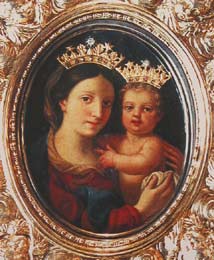Our Lady of Confidence
Our Lady of Confidence
Q: Who is Our Lady of Confidence?
 The Beauty of Mary
The Beauty of Mary
A: The picture was painted by the great Italian painter Carlo Maratta (1625-1713), who was knighted by Pope Clement XI in 1704 and made court painter by Louis XIV the same year. It is said that the renowned artist gave this painting to a young noble woman, who would become the Abbess of the Convent of Poor Clares of St. Francis in the city of Todi.
That Abbess, today Venerable Sister Clara Isabel Fornari, embraced a severe life of penance and was favored with many mystical graces; she even received the Sacred Stigmata of Our Lord’s Passion. Sister Clara Isabel had a great devotion to the Blessed Mother, like all the saints, and a very special attachment to this maternal image of Our Lady with the Divine Infant. For Our Lady had made a remarkable promise to Sister Clara Isabel that would win special graces for herself, her sisters and all those through the ages who would venerate this image.
Due to numerous cures and conversions worked through the intercession of Our Lady of Confidence, copies of the portrait were made and circulated. One of these copies was placed in the small chapel of St. Mary’s Seminary at the Lateran Basilica in Rome. The seminarians soon realized that their prayers and needs were always attended to by the Madonna della Fiducia.
Further, Our Lady of Confidence protected them in times of crisis. She granted the seminarians full protection against the scourge of Asiatic flu, which claimed many lives in Rome in 1837, and again some thirty years later. During World War I, when over one hundred seminarians were forced into the armed services of Italy, they placed themselves under her special care. All returned home safely. To repay the goodness of their Queen, the seminarians crowned both Mother and Child with golden bejeweled diadems.
This image encourages and inspires that confidence. In keeping with the Renaissance style of depicting Our Lady and the saints as regional types, the Blessed Virgin, with her auburn hair, hazel eyes and soft complexion, appears as a northern Italian beauty. Serene and noble, She bears in her arms her great Treasure, Who has the commanding air of a Great Prince. With a surprising imperative gesture, Our Lord points directly to His Mother, as if to tell us, “If you would come to Me, go to her. For what she asks of Me, I will give her.”
The picture teaches us what the Holy Church has always instructed: Our Lord Jesus Christ always acts through Mary as a channel. All conversions and favors take place by means of and through the intercession of this Blessed Mother. We need only approach with the confidence of a child in his mother to be certain she will attend to our needs. Mankind today does not have this lively confidence in the maternal love of Our Queen, and, because of this, we do not take advantage of the universal channel of grace for mankind.
All About Mary includes a variety of content, much of which reflects the expertise, interpretations and opinions of the individual authors and not necessarily of the Marian Library or the University of Dayton. Please share feedback or suggestions with marianlibrary@udayton.edu.
